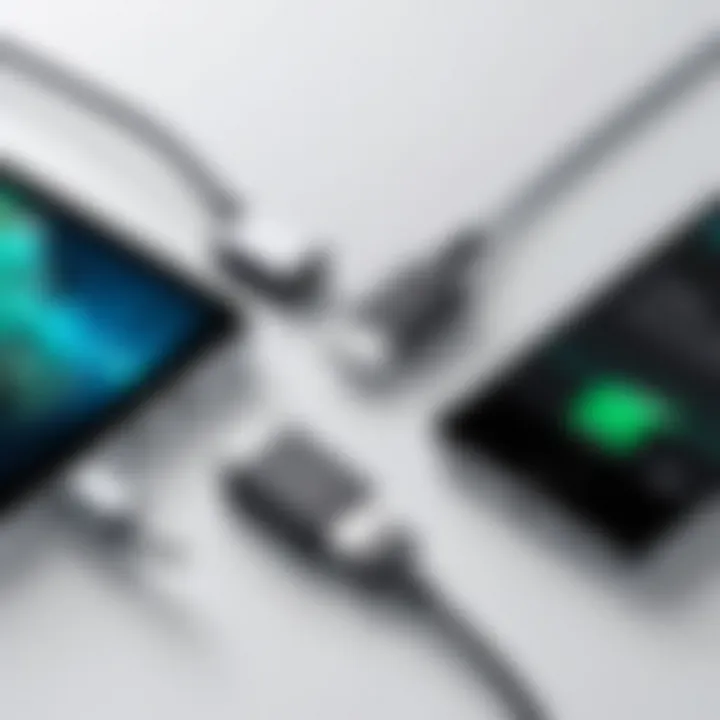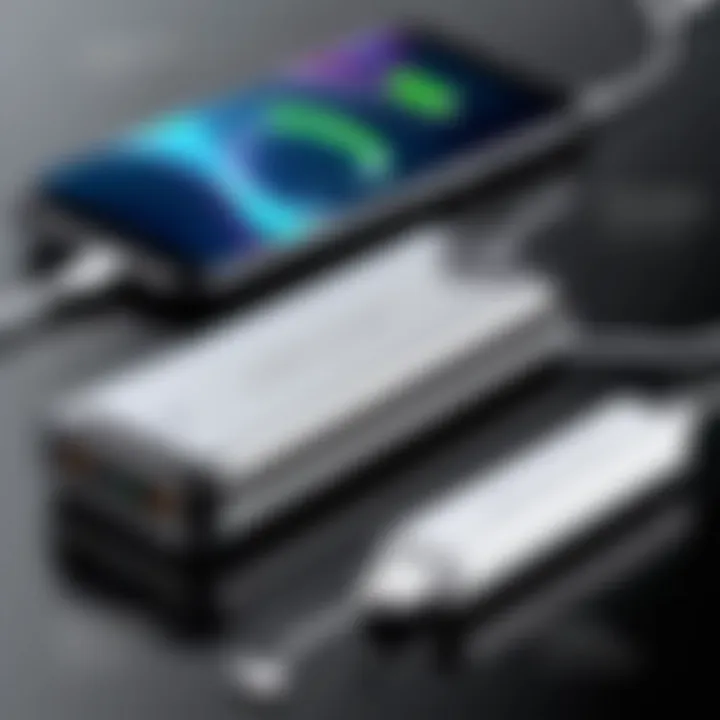Understanding USB-C Portable Phone Chargers


Intro
In a world where smartphones are essential, ensuring these devices remain charged is vital. Portable phone chargers provide a convenient solution to keep devices powered on-demand. This article centers on USB-C technology, focusing on the benefits and potential drawbacks of its use in portable charging solutions. As consumers become more reliant on technology, understanding the functionality of these chargers is crucial for informed purchasing decisions.
Technical Specifications
Detailed Product Specs
USB-C portable chargers are designed with versatility in mind. They offer various capacities, typically ranging from 5,000mAh to 30,000mAh. This range gives users the flexibility to choose a charger based on their specific needs and usage patterns. Chargers with higher mAh ratings can power devices multiple times before requiring a recharge themselves.
Many USB-C portable chargers are equipped with Power Delivery technology. This allows for faster charging capabilities, enabling users to recharge their devices effectively. Important metrics include the output power, which can range from 10W to over 60W, depending on the charger model. Supporting various power outputs ensures compatibility with a broad range of devices.
Performance Metrics
Performance metrics are important for evaluating portable phone chargers. Charging speed, durability, and efficiency are primary factors. Many users appreciate chargers that can deliver up to 50% battery in around 30 minutes, significantly reducing downtime. Additionally, users should consider heat management during charging, as excess heat can diminish battery performance over time.
Compatibility Information
One key advantage of USB-C technology is its universal compatibility with multiple devices. Unlike older charging standards, USB-C can charge smartphones, tablets, laptops, and even some gaming devices. When selecting a portable charger, it is important to confirm that the device supports USB-C input and output.
Product Comparisons
Feature Comparisons
Comparing features across different brands can help consumers select the right portable charger. Consider factors such as the number of output ports, weight of the charger, and additional features like built-in cables or LED indicators. Brands like Anker, Aukey, and RAVPower offer distinct features tailored to varying user needs.
Price Breakdown
Price can vary significantly based on brand, capacity, and functionality. A basic 10,000mAh USB-C charger can range from $20 to $40. In contrast, high-capacity models with advanced features may cost upwards of $70. Users should weigh value propositions against price when making a decision.
User Experience Breakdown
User experience often dictates product choice, especially for portable chargers. Reviews can provide insight into real-world usage scenarios. Common feedback includes charging speed, reliability, and general ease of use. Consumers are likely to favor products with high ratings, showcasing satisfaction from previous buyers.
Practical Applications
Use Cases for Different Users
Understanding how different users interact with technology can inform their portable charger choices. For instance, frequent travelers might prioritize lightweight design and fast charging capabilities. In contrast, gamers may seek high-capacity chargers that can support prolonged gaming sessions.
Recommended Configurations
Using specific configurations can optimize charging performance. Users with multiple devices should consider multi-port chargers that can charge various devices simultaneously. Ensuring compatibility with both input and output is essential for achieving optimal charging rates.
Multi-Platform Performances
USB-C's adaptability makes it a suitable choice for several devices. Whether charging a smartphone, tablet, or laptop, the performance remains consistent if the device supports USB-C. This simplifies the process of carrying charges for varied devices.
Latest Trends
Industry Developments
As technology advances, USB-C continues to gain traction. Many manufacturers are shifting towards this standard, making it more prominent in consumer electronics. Industry support signals a promising future for USB-C compatibility across devices.
Emerging Technologies
Notably, developments in fast charging technologies are expected to align with USB-C's capabilities. Innovations in battery chemistry, such as solid-state batteries, may enhance the efficiency and speed of portable chargers.
Future Predictions
Going forward, the expectation is that USB-C will become the universal standard across devices. As demand for fast charging solutions grows, manufacturers will likely focus on enhancing performance while maintaining compatibility.
Buying Guides
Recommended Products
Several USB-C portable chargers stand out. Anker PowerCore Series, Aukey's Omnia Duo, and RAVPower 26,800mAh options provide robust functionality and reliability.
Purchasing Tips
When purchasing a portable charger, inspect the product specifications closely. Ensure the charger meets your power needs, and assess user reviews for insights into performance and reliability.
Warranty and Support Information


Warranties vary between manufacturers. A reliable product typically offers a minimum one-year warranty. It's wise to check the support options available in case of issues with the charger.
Prologue to Portable Phone Chargers
In a world that increasingly relies on mobile devices, the role of portable phone chargers has never been more significant. These devices are essential for maintaining connectivity and productivity, serving as a lifeline when access to traditional power sources is limited. Understanding portable phone chargers is not merely about convenience; it addresses a fundamental need in modern society. From the busy professional working remote to the student frequently on campus, the ability to charge a device on-the-go closely influences daily activities.
Defining Portable Phone Chargers
Portable phone chargers, commonly referred to as power banks, are compact devices designed to store electrical energy. They allow users to recharge their smartphones, tablets, and even laptops when no standard power outlet is available. These chargers come equipped with a battery, usually made of lithium-ion, and have one or more USB ports for connecting devices. Importantly, the capacity of a portable charger is often measured in milliamp hours (mAh), indicating how much charge it can store. The higher the mAh rating, the more power the charger can provide.
Importance in Modern Life
The importance of portable phone chargers in contemporary life cannot be overstated. As reliance on mobile technology grows, so does the need to keep devices powered. A study by Pew Research highlights that over 85% of Americans own a smartphone. In many cases, these devices are essential tools for communication, navigation, and information access. When battery life dwindles, productivity can suffer dramatically.
Moreover, portable chargers offer freedom and flexibility. They break the constraints posed by wall outlets, granting users the ability to charge their devices in various situations such as during commutes, at events, or while traveling. For example, a gamer gearing up for a long session on the go can ensure their device remains charged with a portable charger, enhancing their experience without interruptions.
In addition to convenience, security has become a factor too. Power banks become essential during emergencies or power outages, providing a necessary backup. Overall, the adoption of portable phone chargers reflects a broader trend toward mobile-first lifestyles, reinforcing their relevance in today’s tech-driven culture.
"Portable phone chargers are not just a luxury; they are now a necessity to keep us connected in an increasingly digital world."
Understanding the intricacies of portable chargers lays the foundation for exploring USB-C technology. USB-C represents a significant advancement in charging, offering a range of benefits that enhance the experiences of users across the globe.
Understanding USB-C Technology
Understanding USB-C technology is crucial when discussing portable phone chargers. As the landscape of device compatibility shifts, the need for efficient and versatile charging solutions becomes evident. USB-C is not merely an update; it represents a significant advancement in charging and data transfer technology. This section explores the details of USB-C, its historical context, and its many benefits.
What is USB-C?
USB-C, or Universal Serial Bus Type-C, is a connector specification that enhances both power and data transfer capabilities. Unlike its predecessors, USB-C can transmit data, video, and power simultaneously. This versatility allows for a single cable to perform multiple functions, thus reducing clutter in device management.
The connector is distinguishable by its oval shape, making it reversible, so users do not have to worry about orientation. USB-C supports the USB Power Delivery (PD) protocol, enabling faster charging rates, which can be up to 100 watts. This is particularly beneficial for high-performance devices, such as laptops and gaming consoles, that require significant power.
In addition to charging speed, USB-C also supports high-resolution video output, notably 4K and even 8K in some cases. This capability enhances productivity and entertainment experiences significantly, allowing for seamless transitions between devices.
History and Evolution of USB Standards
The evolution of USB standards is marked by the quest for increased efficiency and functionality. The original USB standard, USB 1.0, was introduced in 1996 and facilitated a maximum transfer rate of 1.5 Mbps. As technology progressed, USB 2.0 emerged in 2000, boasting speeds of 480 Mbps. The introduction of USB 3.0 in 2008 saw even greater speeds, reaching up to 5 Gbps.
Each iteration of USB brought enhancements, but the advent of USB-C marks a turning point. Introduced in 2014, USB-C addressed many limitations of previous types, merging power delivery and data transfer in one application. The connector’s compact design and functionality appealed to manufacturers and developers, leading to its widespread adoption across various devices.
USB-C is set to become the standard charging connection for most electronic devices, including smartphones, laptops, and tablets.
As we examine USB-C, it becomes clear that this technology not only simplifies user experiences but also aligns well with the growing demand for sustainability through reduced electronic waste. More usability in fewer cables is a step forward in crafting an effective and sustainable device ecosystem.
Overall, understanding USB-C technology is essential for consumers looking to maximize their portable charging solutions. The blend of speed, compatibility, and versatility makes USB-C a pivotal component in modern electronic usage.
Advantages of USB-C Portable Chargers
USB-C portable chargers have gained significant traction in the market due to their various advantages that cater to modern needs. Understanding these benefits is crucial for consumers looking to make informed choices in their quest for efficient and reliable charging solutions. As technology evolves, USB-C is increasingly recognized as the standard for charging and data transfer across multiple devices, which leads to a deeper analysis of its advantages.
Fast Charging Capabilities
One of the primary advantages of USB-C portable chargers is their fast charging capabilities. They support higher power output, allowing gadgets to charge at much quicker rates compared to traditional USB chargers. This feature is especially beneficial for users with devices like smartphones and laptops that require frequent charging during busy days. For instance, many USB-C chargers can supply up to 100 watts of power via Power Delivery technology, which significantly reduces the time taken to charge devices.
"The ability to charge a smartphone to about 50% in just 30 minutes is a game-changer for many users."
This rapid charging not only enhances convenience but also aligns with the on-the-go lifestyle that many today embrace. However, achieving fast charging often requires compatible devices and cables. Consumers must pay attention to their devices' specifications to ensure they utilize these capabilities effectively.
Universal Compatibility
Another remarkable trait of USB-C portable chargers is their universal compatibility. Unlike previous USB versions, which were often limited by the type of connectors, USB-C has standardization benefits. This means that a single charger can typically power a multitude of devices—smartphones, tablets, laptops, and even certain peripherals like cameras and headphones.
This universality reduces the clutter of cables in bags and enables a simplified charging solution. Users no longer have to carry multiple chargers for different devices. It's important, however, to check if the device supports USB-C charging, as compatibility varies depending on the manufacturer and model.
Additionally, many modern gadgets, including Apple's MacBook series and various Android devices, are now adopting USB-C as their charging standard. This trend confirms that USB-C chargers represent a forward-thinking investment for consumers looking to future-proof their charging solutions.
Reversible Connector Design
The design of USB-C connectors offers yet another benefit: the reversible nature of the connector. This means that whether users connect their charger upside down or right side up, it will fit into the port without hassle. Such a simple feature removes the frustration often associated with traditional USB connectors, making the overall user experience more seamless.
This design aspect caters to both ease of use and the potential for fewer wear-and-tear issues over time. Since users don't have to worry about orientation, the likelihood of damaging both the charger and device ports diminishes significantly. This straightforward, user-friendly design is particularly advantageous for everyday users who prefer convenience without the complexity.
Limitations of USB-C Portable Chargers
When discussing portable phone chargers, it is essential to look beyond the advantages of USB-C technology. Understanding the limitations provides a balanced view of its functionality and utility. Recognizing these limitations can guide consumers towards making informed decisions in their purchasing process.


Compatibility Issues with Older Devices
One of the primary concerns regarding USB-C portable chargers is the compatibility with older devices. Many consumers still use smartphones and tablets that rely on Micro USB or proprietary connectors. These devices cannot utilize USB-C chargers without an adapter. Using an adapter often introduces additional complexities, such as varying charging speeds and unreliable connections. Furthermore, some devices may not fully support the fast charging capabilities inherent to USB-C standards, leading to slower charging rates than expected.
"While USB-C presents numerous advantages, understanding its limitations in compatibility with older tech is crucial for user satisfaction."
Additionally, older laptops and accessories might not support USB-C at all. When choosing a USB-C portable charger, users must consider their current devices. If the primary devices they own do not support USB-C, the benefits of a USB-C charger diminish significantly. Consumers should therefore evaluate their existing technology landscape before investing in a USB-C portable charging solution.
Varied Charging Speeds
Another limitation involves the varied charging speeds associated with USB-C portable chargers. While USB-C technology is designed for fast charging, the actual speed depends on several factors, including the specific device, cables used, and charger specs. For instance, if a user connects a USB-C charger to a device that supports only slower charging protocols, the charging rate will not reach its potential.
Not all USB-C chargers deliver the same power output. Some may offer only basic speeds, while others are optimized for fast charging. This makes it essential for consumers to check the power delivery specifications when selecting a charger. If performance is a priority, understanding these specifications can aid in navigating a market filled with various options.
Key Features to Look for in a USB-C Charger
When selecting a USB-C portable charger, several key features demand attention. These features significantly influence the device's performance and user experience. The right charger can make a difference between a long day without power or a seamless gadget experience. Here, we will scrutinize three essential characteristics that one must consider when investing in a USB-C charger: Power Delivery Specifications, Battery Capacity, and Port and Cable Quality.
Power Delivery Specifications
Power Delivery (PD) is a crucial feature to consider in a USB-C charger. It enables faster charging for compatible devices by allowing higher voltages. Typically, standard USB chargers deliver power at 5V. In contrast, USB Power Delivery can supply up to 20V, depending on device requirements. This technology ensures a more efficient charging process, reducing waiting time.
An understanding of the PD specifications can help consumers choose the right charger for their devices. Look for chargers that list their PD capabilities, often indicated in Watts (W). For instance, a 30W charger can adequately power laptops, faster than the typical 5W or 10W chargers used for phones. Keep in mind your devices’ needs and select a charger that delivers adequate power.
Battery Capacity
Battery capacity is an inherent factor in determining how effectively a portable charger can serve its purpose. Measured in milliamp hours (mAh), this figure indicates how much charge a device can store. The larger the capacity, the more charge it can provide to connected devices.
For practical guidance, a charger with over 10,000 mAh can be ideal for smartphones. It allows most users to charge their devices multiple times before needing a recharge. If you plan to charge larger devices like tablets or laptops, consider chargers starting at 20,000 mAh or more. Note that higher capacity chargers tend to be heavier and larger in size, so balance your needs with portability.
Port and Cable Quality
The quality of the ports and cables is essential. Inferior ports can lead to charging failures or even device damage. Ensure that the ports comply with the latest USB-C standards for safety and performance. A reputable charger should have well-rated ports designed to withstand frequent use.
Similarly, cables play a critical role in overall charging efficiency. High-quality cables should support the PD standards of the charger for optimal results. When choosing cables, look for certifications such as USB-IF to guarantee compatibility and safety.
Investing in a charger with the right Power Delivery, battery capacity, and quality components can enhance your charging experience significantly.
For more information, you can further explore resources like Wikipedia or engage in community discussions about your preferences on Reddit.
By scrutinizing these features, tech-savvy consumers can make informed choices that cater to their specific requirements, whether they are gamers, PC builders, or everyday users.
Compatibility with Mobile Devices
In a world where mobility is paramount, the compatibility of portable chargers with various mobile devices is crucial. A portable charger that can support multiple devices adds significant convenience and flexibility to the user experience. When choosing a USB-C charger, understanding how well it integrates with smartphones, tablets, and laptops ensures that you can rely on it in various scenarios. Compatibility directly affects charging speed, efficiency, and ease of use. Therefore, knowing which devices work best with these chargers can greatly enhance daily life.
Smartphones
Smartphones are perhaps the most common devices that benefit from portable chargers. Many modern smartphones are designed with USB-C ports, making them readily compatible with USB-C chargers. This connection not only delivers power but can also transfer data efficiently, should the need arise. It is important to ensure that the charger supports fast charging protocols specific to your phone model. For example, some brands like Samsung utilize fast charging that can greatly reduce charging time when paired with the right charger.
Key considerations for smartphone compatibility include:
- Ensure the charger offers the required wattage for your device.
- Check for specific charging protocols like Power Delivery or Qualcomm Quick Charge.
- Consider the length of the USB-C cable; a longer cable can offer more flexibility in usage.
Tablets
Tablets typically have larger batteries than smartphones, warranting a more powerful charging solution. Many tablets, particularly high-performance ones, use USB-C for charging. This is beneficial because tablets often require more power to charge efficiently compared to smartphones. The right portable charger can ensure that your tablet is charged quickly, allowing users to work or play without long interruptions.
Consider these points when looking at tablet compatibility:
- A full charge might require a portable charger with at least 18W output or more, depending on the tablet model.
- Verify that the charger can adapt to the tablet's charging speed without causing any overheating issues.
Laptops
As laptops become more lightweight and portable, their compatibility with USB-C portable chargers grows increasingly important. Many new models are designed to charge via USB-C, which simplifies the charging process. A single charger can serve multiple devices – from smartphones to laptops – reducing clutter.
When considering laptops, pay attention to the following:
- Confirm the required wattage. Laptops tend to consume higher amounts of power.
- Ensure the charger is capable of supporting the laptop's specifications, preventing possible damage.
Mobile devices and their compatibility with portable chargers directly influence the user experience. By understanding these aspects, users can make educated decisions about their charging solutions, ensuring reliability in their everyday tasks.
Buying Considerations for USB-C Chargers


The process of choosing a USB-C portable charger involves several important factors. Understanding these elements can significantly enhance your purchase decision, ensuring that you select a charger that meets both your needs and expectations. The following sections break down critical aspects to contemplate when shopping for these modern charging devices.
Price vs. Performance
When it comes to portable chargers, a balance between price and performance is crucial. Budget chargers might seem attractive, but they may not deliver the required energy output, leading to longer charging times or potential overheating issues. On the other hand, premium models often incorporate superior technology that enables faster charging and longer battery life.
Consider the specifications outlined by the manufacturer. Chargers with Power Delivery (PD) support and higher wattage usually justify a higher price, as they can charge not only phones but also laptops and other devices. Thus, investing a bit more can be worthwhile if you aim for versatile usage.
Brand Reliability
Brand reliability plays a key role when selecting a USB-C charger. Reputable manufacturers often provide better customer support, extended warranties, and improved overall quality. Recognizing well-established brands can save consumers from frustrations tied to defective products.
It is advisable to look at brands like Anker, Belkin, and Aukey, as they are known for their reliable performance. These brands often perform extensive testing and quality checks to ensure their products meet safety regulations and provide efficiency. Consumer trust in these brands is usually rooted in their consistency and long-standing presence in the market.
User Reviews and Ratings
User feedback provides invaluable insight into a product's real-world performance. Reviews and ratings can highlight essential yet overlooked product features, such as usability and compatibility with various devices. A charger may claim high-speed charging, but real customer experiences will help verify these claims.
Consider checking reviews on platforms like Reddit or Facebook before making a final purchase. Pay attention to both the positive and negative comments, as they collectively paint a clearer picture. The consensus among users on charging speeds, durability, and overall satisfaction should guide your choice in the right charger.
In summary, when buying a USB-C charger, it's fundamental to assess the interplay between price and performance, ensure brand reliability, and read user reviews. This pays off in making a well-informed choice that meets your charging needs.
Portable Charger Brands and Models
Choosing the right portable charger can be overwhelming due to the numerous brands and models available. The importance of understanding portable charger brands and models lies in their direct impact on performance, reliability, and overall user satisfaction. Recognizing reputable brands can guide consumers toward better quality options, making the selection process easier and more efficient. In this section, we will explore the top brands in the market and examine some of the best-selling models, shedding light on their advantages and unique features.
Top Brands in the Market
When talking about portable chargers, certain brands stand out due to their consistent quality and innovation. Here are several of the leading brands you may consider:
- Anker: Known for its robust design and efficient power delivery. Anker often integrates advanced charging technology, making it a favorite among tech-savvy users.
- RAVPower: This brand is distinguished for offering high-capacity power banks that cater to various needs. Their chargers are often praised for their reliability and durability.
- Aukey: Recognized for innovation in charging technology, Aukey frequently combines practicality with design, offering stylish and functional products.
- Zendure: Focused on durability, Zendure products tend to withstand harsh conditions while delivering dependable performance.
"Brand reliability has a concrete effect on user experience with portable chargers. High-quality brands tend to have better customer support as well."
Best-Selling Models
In addition to knowing which brands are reputable, it is also valuable to understand which specific models are popular among consumers. Here are some of the best-selling USB-C portable chargers:
- Anker PowerCore 10000: This lightweight and compact power bank is highly praised for its fast charging capabilities. Its size makes it easily portable, perfect for everyday use.
- RAVPower 20000 PD: Equipped with Power Delivery technology, this model can charge laptops and other high-capacity devices quickly. It is an excellent option for users who need more power on the go.
- Aukey PB-N51: Famed for its dual USB-C ports, this power bank provides versatility for charging multiple devices simultaneously. It's a practical choice for those who possess numerous gadgets.
- Zendure A2 Portable Charger: Known for its exceptional durability, the Zendure A2 is ideal for users who travel frequently. Its high quality construction ensures that it can endure accidental drops.
Understanding the brands and models available is crucial in making an informed decision when purchasing a portable charger. By focusing on quality brands and well-reviewed models, users can enhance their satisfaction and ensure their devices remain powered on their terms.
Future Trends in Portable Charging Technology
The field of portable charging technology is undergoing rapid evolution. This section seeks to explore future trends that may shape how users interact with portable phone chargers. As technology advances, understanding these trends can help consumers make informed decisions about their portable charging needs.
Emerging Technologies
One significant innovation expected to impact portable charging technology is wireless charging. Companies are investing considerable resources into enhancing efficiency and reducing charging times for wireless solutions. This includes the adoption of resonant inductive coupling, which allows chargers to function without direct contact with devices. Such developments could eliminate the necessity for physical cables and connectors altogether, simplifying the user experience.
Another emerging technology is solar charging. As interest in sustainability grows, portable chargers equipped with solar panels may become more mainstream. These devices can harness solar energy, offering a green solution for users who favor environmentally-friendly options. Users camping or spending time outdoors might find this especially beneficial.
In addition, advances in battery technology, such as solid-state batteries, offer promises of higher energy density and increased safety. Compared to traditional lithium-ion batteries, solid-state options are less prone to overheating and can potentially charge faster. As these technologies mature, they may redefine the performance benchmarks for portable chargers.
Sustainability and Environmental Impact
Sustainability is a crucial factor in the design of future portable charging solutions. The increasing awareness of environmental issues urges manufacturers to focus on creating eco-friendly products. This shift includes using recyclable materials and minimizing waste during production.
As mentioned earlier, solar-powered chargers represent one path toward increased sustainability. Moreover, manufacturers are exploring ways to enhance energy efficiency. Options that reduce energy loss and ensure longer battery lifespans can make a significant difference in environmental footprint.
Another concern is the growing issue of e-waste. As consumers buy new devices more frequently, the disposal of older chargers contributes significantly to electronic waste. Companies are addressing this by implementing take-back programs and encouraging recycling. This approach not only promotes responsible disposal of old chargers but also aligns with a broader commitment to sustainability.
"The future of portable charging technology will prioritize efficiency and sustainability, reflecting the changing priorities of consumers."
The End
The conclusion of this article serves as a critical recap of the evolving landscape surrounding portable phone chargers, specifically highlighting the significance of USB-C technology. As mobile devices become integral to our daily routines, the chargers we utilize are equally essential. The discussion here encapsulates several core elements that underline the value of USB-C chargers in modern technology.
Summary of Key Points
In this article, we explored multiple facets associated with USB-C portable chargers, such as:
- Fast Charging Capabilities: USB-C technology brings higher power delivery, enabling quicker charge times for smartphones and other devices, thereby increasing utility in busy lifestyles.
- Universal Compatibility: USB-C is now widely adopted across numerous devices, including smartphones, tablets, and laptops, creating a standard that reduces the need for multiple chargers.
- Reversible Connector Design: The user-friendly design eliminates frustration during use, as the connector can be plugged in without concerning about orientation.
- Potential Limitations: While USB-C has several advantages, issues such as compatibility with non-USB-C devices and varying charging speeds remain important considerations.
Overall, these points reinforce the practicality and desirability of adopting USB-C technology in portable charging solutions.
Final Thoughts on USB-C Chargers
As we reflect on the discourse about portable phone chargers, it's evident that USB-C stands out as a major advancement. The shift towards a unified standard paves the way for enhanced user experiences. For tech-savvy consumers, gamers, and PC builders, the implications of choosing USB-C chargers can lead to significant performance gains in terms of convenience and efficiency.
Investing in a quality USB-C charger is no longer just a choice; it is becoming a necessity in our digitally-driven world. Understanding the functional and technical details aids in making informed decisions that align with individual needs and preferences.







